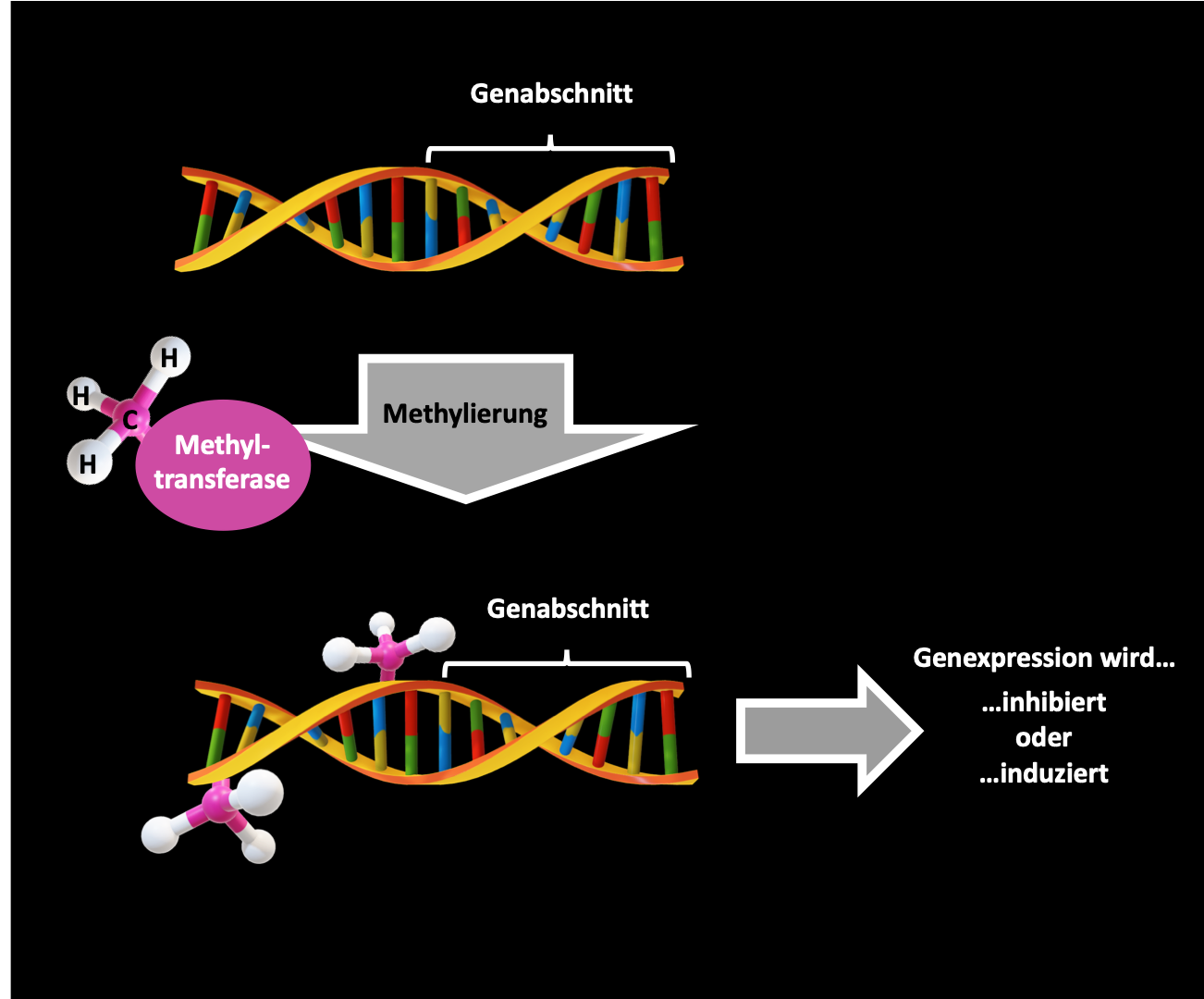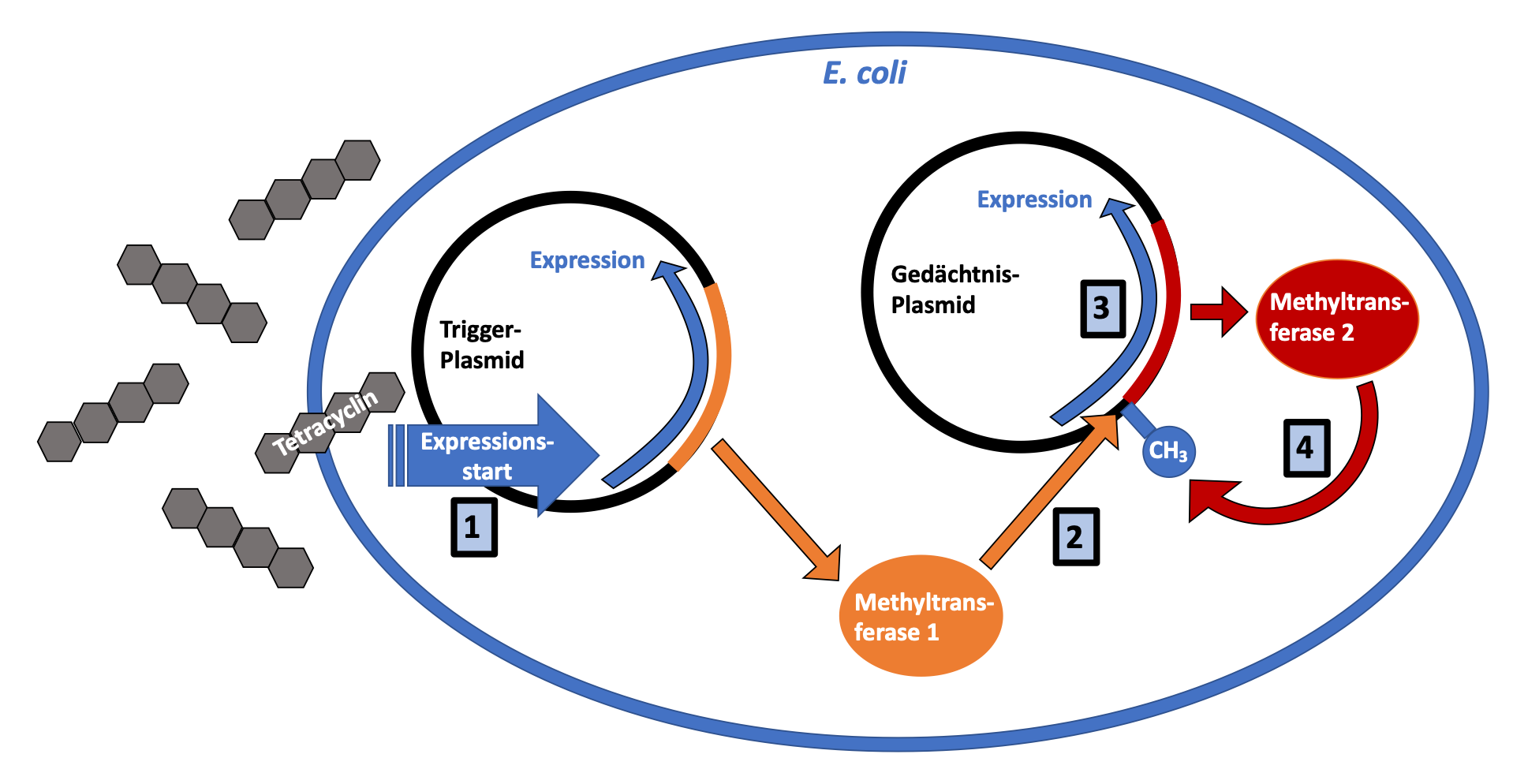Epigenetic switches in bacteria as biosensors
The analysis of pathogen biomarkers and biomarkers for the diagnosis of diseases can be crucial for health. However, the detection of pathogens and diseases depends on a sensitive and reliable method that delivers rapid results. Biosensors have such properties. Researchers at the Institute of Biochemistry and Technical Biochemistry (IBTB) at Stuttgart University have constructed an epigenetic circuit composed of plasmids that might make it possible to use E. coli bacteria as whole-cell biosensors.
Epigenetics (Greek ‘epi’ = outside of, around) refers to mechanisms that modify a DNA strand by attaching small chemical molecules without altering the underlying DNA sequence. This creates a heritable epigenetic pattern of DNA modifications that help regulate gene activity. Unlike the genetic code, where information is encoded in the sequence of DNA bases and is identical in every single body cell, epigenetic patterns vary according to cell type, and can be changed and adapt to different environmental conditions. The epigenome, i.e. all epigenetic modifications in a cell, determines which genes are switched on and off and thus which functions the cell can perform without involving alterations in the underlying DNA sequence.
 Gene regulation via DNA methylation: methyltransferases can attach methyl groups (-CH3) to specific DNA bases and thus inhibit or induce gene expression. © BIOPRO Baden-Württemberg GmbH
Gene regulation via DNA methylation: methyltransferases can attach methyl groups (-CH3) to specific DNA bases and thus inhibit or induce gene expression. © BIOPRO Baden-Württemberg GmbHDNA methylation as epigenetic marker
Researchers led by Prof. Dr. Albert Jeltsch in the Biochemistry Department at the Institute of Biochemistry and Technical Biochemistry (IBTB) at Stuttgart University are researching and optimising enzymes involved in epigenetic processes. One example of such an epigenetic change is DNA methylation, whereby a methyl group (-CH3) is enzymatically attached to a specific base in the DNA by so-called methyltransferases. In nature, the pattern of methyl residues attached to the DNA causes some genes to be transcribed and others to be silenced.
Such epigenetic processes do not just take place in animals, plants and fungi (eukaryotes), but also in bacteria (prokaryotes). This is where the Stuttgart researchers led by Jeltsch come in: they are developing artificial systems in Escherichia coli bacteria that enable the bacteria to react to chemical and physical signals from their environment by storing this information in the form of a DNA methylation pattern. In future, these bacteria could be used as highly sensitive whole-cell biosensors, e.g. for detecting antibiotics in drinking water and industrial pollutants in the environment or for analysing disease biomarkers.
Ability to detect even the smallest quantities of antibiotics
 Prof. Dr. Albert Jeltsch, head of the Department of Biochemistry and managing director of the IBTB at the University of Stuttgart. © Institute of Biochemistry and Technical Biochemistry (IBTB), Stuttgart University
Prof. Dr. Albert Jeltsch, head of the Department of Biochemistry and managing director of the IBTB at the University of Stuttgart. © Institute of Biochemistry and Technical Biochemistry (IBTB), Stuttgart UniversityOne of the future fields of application, antibiotics, are life-saving medicines for humans and animals. However, 30 to 90 percent of these pharmaceuticals enter the environment through urine and faeces and thus ultimately return to drinking water supplies. Consequently, in the long run, they promote the development of antibiotic-resistant pathogens, which can be life-threatening. The accumulation of antibiotics in the environment must therefore be prevented as much as possible. However, so far there have been no sensitive detection methods available to identify areas where antibiotics accumulate and thus enable restrictive measures, such as the use of special drinking water filters, to be introduced in a targeted manner.
Artificial E. coli systems developed by the Stuttgart scientists could be one potential way of detecting even the smallest amounts of antibiotics at low cost. These bacteria, which have a memory system inside them and can also be incorporated into a suitable immobilisation device, could therefore be used as whole-cell antibiotic biosensors for detecting minimal antibiotic contamination in drinking water. Since tetracycline and its derivatives are used for treating a wide range of human diseases as well as in livestock farming, this was the antibiotic chosen to study the sensitivity and suitability of bacterial biosensors. The researchers were able to demonstrate that the whole-cell tetracycline biosensor had an extremely sensitive detection limit. "In our tests, we were able to detect as little as 0.1 μg/l tetracycline, which is interesting in view of residual tetracycline concentrations of up to 2.37 μg/l already measured in wastewater treatment plants," explains Jeltsch. "Furthermore, the system was able to store the one-time exposure to tetracycline over several days." This storage capability enables multi-day drinking water analyses, which could save the costs incurred by having to change measurement instruments on a daily basis.
How does the bacterial biosensor work?
The bacteria obtained biosensory properties through two different synthetically produced DNA plasmids that form a memory system. Both plasmids were taken up by the bacteria by electroporation, a method that makes the bacterial membrane temporarily permeable via an electric field. The presence of the antibiotic tetracycline leads to the expression of a DNA methyltransferase from the first, so-called trigger, plasmid. This DNA methyltransferase then methylates a specific DNA sequence on the memory plasmid. The methylation of this sequence in turn initiates the expression of a second methyltransferase, whereby the presence of tetracycline is stored as methylation mark on the memory plasmid.
 Tetracyclin-inducible epigenetic memory system in E. coli. 1) Tetracyclin leads to the induction of the expression of the first methyltransferase (methyltransferase 1) from the trigger plasmid. 2) Methyltransferase 1 methylates (blue CH3 methyl group(s) lollipop) the memory plasmid. 3) Methyltransferase 1-induced methylation leads to the expression of the second methyltransferase (methyltransferase 2). 4) Memory effect: methyltransferase 2 is able to maintain methylation and hence expression of the memory plasmid even if the initial trigger has disappeared (Maier et al., 2017). © BIOPRO Baden-Württemberg GmbH
Tetracyclin-inducible epigenetic memory system in E. coli. 1) Tetracyclin leads to the induction of the expression of the first methyltransferase (methyltransferase 1) from the trigger plasmid. 2) Methyltransferase 1 methylates (blue CH3 methyl group(s) lollipop) the memory plasmid. 3) Methyltransferase 1-induced methylation leads to the expression of the second methyltransferase (methyltransferase 2). 4) Memory effect: methyltransferase 2 is able to maintain methylation and hence expression of the memory plasmid even if the initial trigger has disappeared (Maier et al., 2017). © BIOPRO Baden-Württemberg GmbHThe special feature of this system is that the expression behaviour of the methyltransferase corresponds to a positive feedback loop, which means that the methyltransferase is expressed from the memory plasmid independent of the trigger signal over several cell divisions even if the initial tetracycline trigger has disappeared. Since the epigenetic memory effect thus generated does not influence the cell’s genetic information, it is unique among existing memory systems, which are based on irreversible DNA sequence changes. Moreover, the researchers are working on further improving the epigenetic memory effect. The aforementioned positive feedback is accompanied by a transient steady increase in methyltransferase concentration. Even very small quantities of tetracycline are therefore able to elicit a strong signal from the biosensor system. Accordingly, the whole-cell biosensor demonstrates a high sensitivity for tetracycline and potentially many other substances, such as disease markers in the body.
Temperature as trigger
The system also includes a temperature-sensitive component - a zinc finger repressor protein. Zinc finger repressor proteins are characterised by a zinc finger domain, which assumes a loop-shaped structure, the so-called zinc finger, due to a centrally bound zinc ion. Zinc fingers are involved in controlling gene expression. With this additional temperature-sensitive component, the whole-cell biosensor, in addition to application as an environmental toxin and disease marker detector, could be used to monitor cold chains. The circuit would be activated when the temperature rises above a certain threshold during the transport of food or during storage of pharmaceuticals in a storage room. This one-time exceeding of the temperature can even be detected several days later thanks to the system’s memory effect.
The combination of high sensitivity, uncomplicated reprogrammability for detecting a wide range of chemical and physical environmental stimuli and the unique memory effect makes the epigenetic whole-cell biosensor a tool with huge potential to replace existing artificial sensors. The researchers now want to work on eliminating false positive signals given by the system to make it even more stable and turn their vision into reality. The final step once the sensor has undergone further optimisation, although how long this will take is currently unknown, would be constructing a suitable immobilisation device to allow the system to be used outside the laboratory.
Epigenetics in the context of disease development
Epigenetics is also a highly topical field of research in human medicine, with abnormal epigenetic processes linked to a variety of cancers and neurodegenerative diseases. For example, loss of function or changes in function of DNA methyltransferases, which maintain part of the epigenome - the cell's methylation pattern - have been identified as carcinogenic factors. Since the cell-specific DNA methylation pattern determines the density of chromatin and thus gene expression, faulty methylation leads to excessive or absent expression of entire gene segments - with serious consequences such as cell degeneration or tissue destruction. Specific subtypes of gastric, colorectal and lung cancer, for example, have characteristic epigenetic patterns that can be used as potential biomarkers and, moreover, starting points for therapeutic and preventive treatment methods. Clearly altered transcription profiles could be identified in neurodegenerative diseases such as Alzheimer's or Huntington's disease as well as amyotrophic lateral sclerosis (ALS) that were attributable to misdirected chromatin organisation.